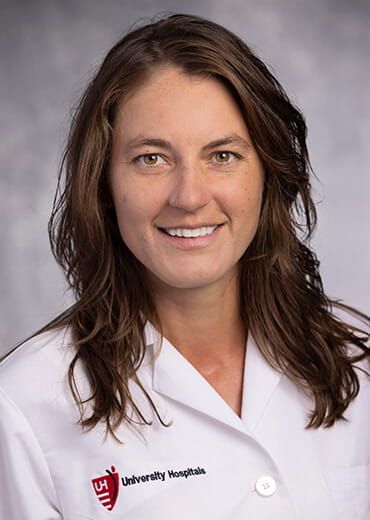Breana Siljander, MD, Joins University Hospitals as Director of Robotic Surgery for Total Joint Replacement
November 07, 2023

Innovations in Orthopaedics | Fall 2023
The newly named Director of Robotic Surgery for Total Joint Replacement at University Hospitals Cleveland Medical Center, Breana Siljander, MD, specializes in the surgical treatment of hip and knee arthritis and revision of failed total joint replacements due to fracture, infection or loosening.
 Breana Siljander, MD
Breana Siljander, MD“We could not be more excited to have Dr. Siljander join our faculty and are honored to have such an accomplished surgeon serve in this capacity,” says James Voos, MD, Chair of the Department of Orthopaedic Surgery and the Jack and Mary Herrick Distinguished Chair of Orthopaedics and Sports Medicine at University Hospitals Cleveland Medical Center. “She trained at the top joint replacement program in the country at Hospital for Special Surgery in New York City and brings expertise in joint replacement and the technological advancements of robotics.”
Dr. Siljander approaches orthopaedics with an engineer’s mindset as she applies engineering principles to care for her patients. She studied mechanical engineering at the University of Michigan at Ann Arbor before earning her medical degree at the University of Michigan Medical School. She also completed an orthopaedic surgery residency at the University of Minnesota in the Twin Cities.
“I am curious by nature and an engineer by education,” says Dr. Siljander. “I like to find the unanswered questions and figure out ways to reliably get better answers for problems we don’t have much information on.”
She explains that the surgical procedure for robotic-assisted joint replacement is similar to traditional approaches in terms of workflow or incision size. “What is unique is the precision of the tool,” says Dr. Siljander. “When you use a machine to execute a task, it is going to reproducibly complete that task each time.”
An Assistant Professor in the Department of Orthopaedic Surgery at School of Medicine, she also holds a secondary appointment as Assistant Professor of Biomedical Engineering within the Case School of Engineering. “Having had such strong mentors train me to where I am now, it is part of my responsibility to contribute to the bigger mission and carry it forward for the next generation,” says Dr. Siljander. “Also, I think teaching is fun — the questions that trainees bring keep me sharp and make me think about what I am doing.”
Dr. Siljander is an active member of the American Academy of Orthopaedic Surgeons (AAOS), the American Association of Hip and Knee Surgeons (AAHKS) and the American Orthopaedic Association (AOA). She has contributed to numerous peer-reviewed journals and presented at national conferences on multiple topics in orthopaedics. Her research interests include patient-specific joint replacement and hip and knee replacement in young patients.
She also has a clinical interest in failed joint replacements and revision procedures. “To be able to reconstruct a failed weight-bearing implant like a hip or knee is a unique challenge,” says Dr. Siljander. “My research goals dovetail nicely with the opportunities we have at University Hospitals to bring together clinicians and engineers to grow our academic research of joint replacement.”
An accomplished athlete who enjoys training for marathons and Ironman triathlons, Dr. Siljander is passionate about understanding her patients’ goals. “We want to protect our patients, but sometimes the sports or recreation they want to continue after joint replacement do not fall within traditional post-surgical guidelines,” she says. “I want to understand better how we can safely guide our patients who want to return to their active lifestyle and restore that part of their identity.”
For example, would a distance runner be a good candidate for a cementless joint replacement? Innovations like implantable feedback sensors are providing another means to track progress and customize rehabilitation. “As joint replacement and implantable technologies continue to evolve, we will have a more in-depth understanding of our patients’ recovery and capacity for activity,” she says.
Dr. Siljander is the first female fellowship-trained arthroplasty surgeon at University Hospitals. “Attracting excellence is important to Dr. Voos,” she says. “Fortunately, a byproduct is that we have a diverse group of capable surgeons on our team.”
For more information, please contact Dr. Siljander at Breana.Siljander@UHhospitals.org.
Contributing Experts:
Breana Siljander, MD
Director of Robotic Surgery, Total Joint Replacement
Department of Orthopaedic Surgery
University Hospitals Cleveland Medical Center
Assistant Professor
Orthopaedic Surgery
Biomedical Engineering
Case Western Reserve University School of Medicine
James Voos, MD
Chair
Department of Orthopaedic Surgery
Jack and Mary Herrick Distinguished Chair
Orthopaedics and Sports Medicine
University Hospitals Cleveland Medical Center
Charles H. Herndon Professor and Chair of Orthopaedics
Case Western Reserve University School of Medicine
Head Team Physician, Cleveland Browns
Medical Director, Cleveland Ballet


